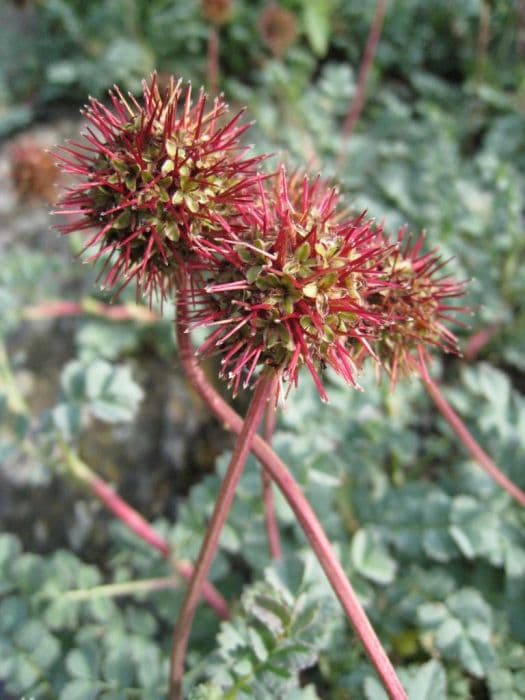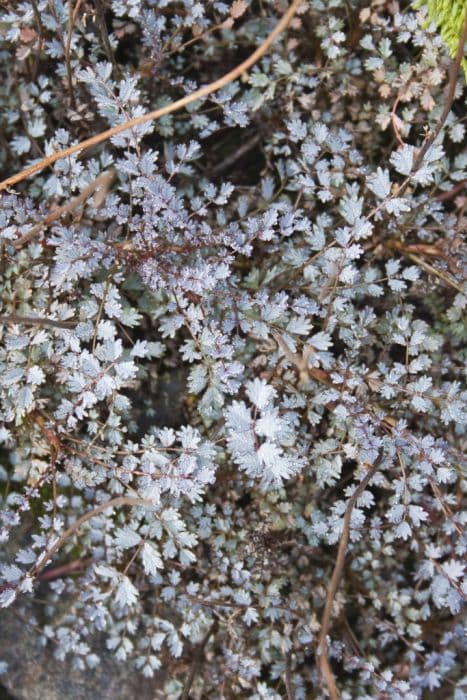Kune Kune Grass Acaena microphylla

ABOUT
The Acaena microphylla, commonly known as Kune Kune grass, is a ground-covering plant that is notable for its carpeting habit. It often spreads across the soil with its stems that root at intervals. The leaves of Kune Kune grass are small, finely divided, and fern-like, imparting a soft, fine-textured appearance to the foliage. These leaves are generally a green or bronze-green color and can turn more bronze with the onset of cooler temperatures. The plant is adorned with small, globular flowers during its blooming period. These flowers are usually red to reddish-brown and are held above the foliage on slender stalks. Following the flowers, Kune Kune grass produces burr-like seed heads which are spiky to the touch and persist well after the flowering season, often giving the plant a distinctive appearance even as the seasons change. Kune Kune grass forms a low mat, which makes it an excellent choice for use as a ground cover in gardens, where it fills in spaces and can help inhibit weed growth. Its textured leaves and spiky seed heads add visual interest and contrast when planted amongst other garden plants.
About this plant
 Names
NamesFamily
Rosaceae.
Synonyms
Small-leaf Acaena, Kune Kune.
Common names
Acaena buchananii, Acaena novae-zelandiae.
 Characteristics
CharacteristicsLife cycle
Perennials
Foliage type
Evergreen
Color of leaves
Green
Flower color
Red
Height
0.1 feet (3 cm)
Spread
1 foot (30 cm)
Plant type
Creeper
Hardiness zones
6
Native area
New Zealand
Benefits
 General Benefits
General Benefits- Ground Cover - Acaena microphylla, commonly known as Bronze Carpet, serves as an excellent ground cover, filling in gaps and reducing soil erosion.
- Aesthetic Appeal - With its fine-textured foliage and low-growing habit, it adds a touch of decorative beauty to garden landscapes.
- Drought Tolerance - Once established, it is quite tolerant of dry conditions, requiring minimal water to thrive, which conserves water resources.
- Low Maintenance - It requires very little maintenance, making it ideal for gardeners seeking a low-effort plant.
- Wildlife Support - It can provide habitat and food for various insects and small animals, supporting local biodiversity.
- Soil Health - Its root system can help to improve soil structure and health over time.
 Medical Properties
Medical PropertiesThis plant is not used for medical purposes.
 Air-purifying Qualities
Air-purifying QualitiesThis plant is not specifically known for air purifying qualities.
 Other Uses
Other Uses- Lawn alternative: Acaena microphylla, also known as 'Blue Haze', can be used as a low ground cover, offering an alternative to traditional grass lawns with its dense mat-forming habit, which requires less maintenance.
- Erosion control: Its ability to spread quickly makes it effective for stabilizing soil and controlling erosion on slopes or in problem areas in the landscape.
- Garden edging: 'Blue Haze' is often planted along the edges of garden paths and borders for its decorative blue-green foliage and reddish spiky seed heads.
- Landscape design: The plant’s unique texture and color can add contrast to rock gardens or complement other plants when used in ornamental garden design.
- Stepable plant: Due to its hardy nature, it can withstand light foot traffic, making it suitable for growing between stepping stones or in patio crevices.
- Culinary decoration: While not commonly eaten, the attractive seed heads of 'Blue Haze' can be used as a decorative element in plating and presentation of culinary dishes.
- Floral arrangements: Dried seed heads have an interesting texture and can be used in dried floral arrangements or as a part of craft projects.
- Ecological support: 'Blue Haze' provides ground cover that can support local ecosystems by providing habitat for small insects and other invertebrates.
- Photography subject: With its intricate seed heads and dense foliage, it can serve as a unique subject for close-up photography, especially for garden bloggers or nature photographers.
- Education: 'Blue Haze' can be used in educational settings such as school gardens to teach about ground covers and the role they play in garden ecology and design.
Interesting Facts
 Feng Shui
Feng ShuiThe Acaena microphylla, commonly known as the "New Zealand burr," is not used in Feng Shui practice.
 Zodiac Sign Compitability
Zodiac Sign CompitabilityThe New Zealand burr is not used in astrology practice.
 Plant Symbolism
Plant SymbolismAcaena microphylla, known commonly as "New Zealand burr," does not have a widely recognized symbolic meaning as it is not commonly featured in historical or cultural symbolism in the same way that plants like roses or lilies are. There is no widely accepted list of symbolic meanings for Acaena microphylla due to its relatively low profile in cultural consciousness and horticultural symbolism.
 Water
WaterNew Zealand Burr requires even moisture and should be watered regularly, especially during extended periods of drought. Water the plant deeply once a week, providing about 1 gallon of water per square yard of soil, which helps encourage deep root growth. During the hottest parts of the summer, watering frequency may need to increase to twice a week if the top inch of soil becomes dry. Make sure to water directly at the base of the plant to avoid wetting the foliage, which can lead to fungal diseases.
 Light
LightNew Zealand Burr thrives best in full sun to partial shade. The ideal spot for this ground cover is an area where it can receive at least 6 hours of sunlight a day, and some dappled shade during the hottest part of the afternoon. In sites with very hot summers, afternoon shade will help prevent the leaves from scorching.
 Temperature
TemperatureNew Zealand Burr prefers a temperate climate and the ideal temperature range for growing it is between 60°F to 75°F. It can tolerate minimum temperatures down to around 20°F but should be protected from harsh, freezing conditions. Maximum temperatures should ideally not exceed 85°F for prolonged periods as this could stress the plant.
 Pruning
PruningNew Zealand Burr doesn't require extensive pruning, but a light trim can be done to maintain its compact form and to remove any dead or damaged foliage. The best time to prune is in late winter or early spring before new growth begins. Pruning can be done annually or as needed to shape the plant and encourage denser growth.
 Cleaning
CleaningAs needed
 Soil
SoilThe best soil mix for New Zealand Burrs should be well-draining and light with an acidic to neutral pH level between 5.0 and 7.0. A mixture of two parts peat, one part perlite, and one part loamy soil will support this plant's growth.
 Repotting
RepottingNew Zealand Burrs do not frequently need repotting; it should be done every 2-3 years or when the plant has outgrown its current container.
 Humidity & Misting
Humidity & MistingNew Zealand Burrs thrive in average room humidity levels. While they are quite adaptable, aim for humidity levels between 40-60% for optimal growth.
 Suitable locations
Suitable locationsIndoor
Place in bright, indirect light and ensure good air circulation.
Outdoor
Plant in partial shade, protect from hot afternoon sun.
Hardiness zone
6-9 USDA
 Life cycle
Life cycleAcaena microphylla, also known as Bronze Carpet, begins its life cycle with germination, which occurs in warm, moist soil conditions after the seeds are dispersed. Following germination, the seedlings grow rapidly, developing a dense, mat-forming foliage with small, pinnate leaves that are bronze-tinted when young and turn green with age. This perennial plant reaches maturity when it begins to flower, typically displaying small, inconspicuous red to brown flowers during the summer. After pollination, typically by wind or insects, fruiting occurs with the production of small, spiky burrs that contain the seeds. These burrs can attach to animals or be distributed by other natural means, aiding in the spread of the species. The plant can also spread vegetatively through its rhizomatous root system, allowing it to cover ground and create new plants from portions of the root.
 Propogation
PropogationPropogation time
Spring to summer
Propogation: The most popular method of propagating Acaena microphylla, commonly known as bronze carpet, is through division. This process is best done in the spring when the plant's growth is most vigorous. To propagate by division, carefully dig up the plant and gently separate the root ball into smaller sections, ensuring that each new section has a piece of the root system attached. You should then replant these divisions into well-draining soil, maintaining the same depth they were originally growing. Water the new plants thoroughly after planting to help establish them. It's important to keep the soil moist but not waterlogged during the initial growth period to encourage strong root development.









